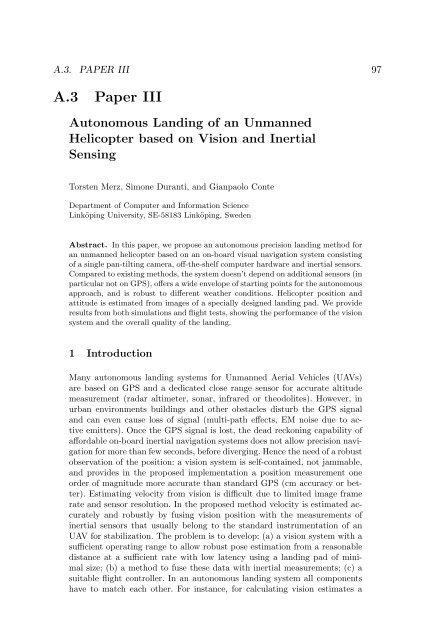Navigation Functionalities for an Autonomous UAV Helicopter
Navigation Functionalities for an Autonomous UAV Helicopter
Navigation Functionalities for an Autonomous UAV Helicopter
Create successful ePaper yourself
Turn your PDF publications into a flip-book with our unique Google optimized e-Paper software.
A.3. PAPER III 97<br />
A.3 Paper III<br />
<strong>Autonomous</strong> L<strong>an</strong>ding of <strong>an</strong> Unm<strong>an</strong>ned<br />
<strong>Helicopter</strong> based on Vision <strong>an</strong>d Inertial<br />
Sensing<br />
Torsten Merz, Simone Dur<strong>an</strong>ti, <strong>an</strong>d Gi<strong>an</strong>paolo Conte<br />
Department of Computer <strong>an</strong>d In<strong>for</strong>mation Science<br />
Linköping University, SE-58183 Linköping, Sweden<br />
Abstract. In this paper, we propose <strong>an</strong> autonomous precision l<strong>an</strong>ding method <strong>for</strong><br />
<strong>an</strong> unm<strong>an</strong>ned helicopter based on <strong>an</strong> on-board visual navigation system consisting<br />
of a single p<strong>an</strong>-tilting camera, off-the-shelf computer hardware <strong>an</strong>d inertial sensors.<br />
Compared to existing methods, the system doesn’t depend on additional sensors (in<br />
particular not on GPS), offers a wide envelope of starting points <strong>for</strong> the autonomous<br />
approach, <strong>an</strong>d is robust to different weather conditions. <strong>Helicopter</strong> position <strong>an</strong>d<br />
attitude is estimated from images of a specially designed l<strong>an</strong>ding pad. We provide<br />
results from both simulations <strong>an</strong>d flight tests, showing the per<strong>for</strong>m<strong>an</strong>ce of the vision<br />
system <strong>an</strong>d the overall quality of the l<strong>an</strong>ding.<br />
1 Introduction<br />
M<strong>an</strong>y autonomous l<strong>an</strong>ding systems <strong>for</strong> Unm<strong>an</strong>ned Aerial Vehicles (<strong>UAV</strong>s)<br />
are based on GPS <strong>an</strong>d a dedicated close r<strong>an</strong>ge sensor <strong>for</strong> accurate altitude<br />
measurement (radar altimeter, sonar, infrared or theodolites). However, in<br />
urb<strong>an</strong> environments buildings <strong>an</strong>d other obstacles disturb the GPS signal<br />
<strong>an</strong>d c<strong>an</strong> even cause loss of signal (multi-path effects, EM noise due to active<br />
emitters). Once the GPS signal is lost, the dead reckoning capability of<br />
af<strong>for</strong>dable on-board inertial navigation systems does not allow precision navigation<br />
<strong>for</strong> more th<strong>an</strong> few seconds, be<strong>for</strong>e diverging. Hence the need of a robust<br />
observation of the position: a vision system is self-contained, not jammable,<br />
<strong>an</strong>d provides in the proposed implementation a position measurement one<br />
order of magnitude more accurate th<strong>an</strong> st<strong>an</strong>dard GPS (cm accuracy or better).<br />
Estimating velocity from vision is difficult due to limited image frame<br />
rate <strong>an</strong>d sensor resolution. In the proposed method velocity is estimated accurately<br />
<strong>an</strong>d robustly by fusing vision position with the measurements of<br />
inertial sensors that usually belong to the st<strong>an</strong>dard instrumentation of <strong>an</strong><br />
<strong>UAV</strong> <strong>for</strong> stabilization. The problem is to develop: (a) a vision system with a<br />
sufficient operating r<strong>an</strong>ge to allow robust pose estimation from a reasonable<br />
dist<strong>an</strong>ce at a sufficient rate with low latency using a l<strong>an</strong>ding pad of minimal<br />
size; (b) a method to fuse these data with inertial measurements; (c) a<br />
suitable flight controller. In <strong>an</strong> autonomous l<strong>an</strong>ding system all components<br />
have to match each other. For inst<strong>an</strong>ce, <strong>for</strong> calculating vision estimates a

















